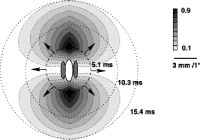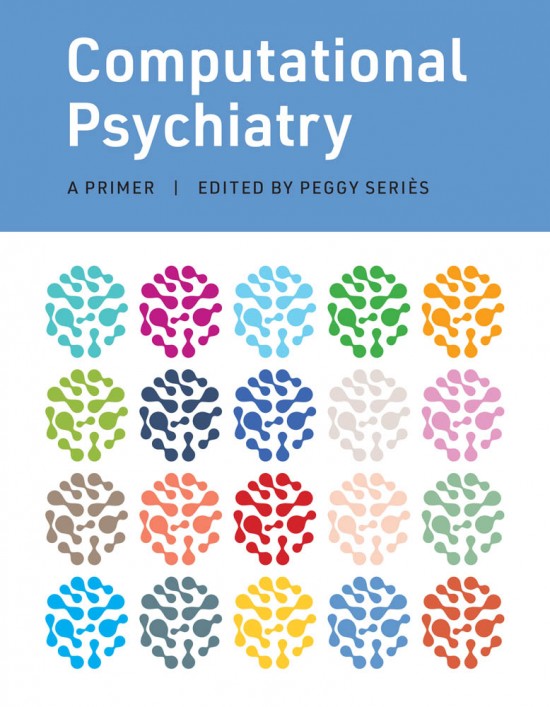Recent
An updated list of my publications can also be found on my google scholar page.
P. Seriès (2021), The ‘circular inference’model of schizophrenia gets pulled into the orbit of social cognition , Brain, 2021 (invited commentary). ay 13:awab126. doi: 10.1093/brain/awab126. (Invited Commentary)
N.A Chrysaitis, R Jardri, S Denève, P Seriès (2021). No increased circular inference in autism or autistic traits , 2021, PLoS Computational Biology.
R. Paredes, F. Ferri, P. Seriès (2021). Influence of E/I balance and pruning in peri-personal space differences in schizophrenia: a computational approach . Schizophrenia Research.
J.P. Noel, R Paredes, E Terrebonne, JI Feldman, T Woynaroski, CJ Cascio, P. Seriès, M. Wallace (2021). Inflexible Updating of the Self-Other Divide During a Social Context in Autism; Psychophysical, Electrophysiological, and Neural Network Modeling Evidence . Biological Psychiatry: Cognitive Neuroscience and Neuroimaging, 2, 2021. Doi:10.1016/j.bpsc.2021.03.013.
A. Stolicyn, J.D. Steele and P.Series, Prediction of depression symptoms in individual subjects with face and eye movement tracking (2020), Psychological Medicine, Nov 9; 1-9 .
K. Richards, P. Karvelis, S. Lawrie and P. Series, Visual statistical learning and integration of perceptual priors are intact in ADHD (2020) , Plos One.
S. Rupprechter, A. Stankeviciu, Q.J.M. Huys, P. Series, J.D. Steele (2020). Abnormal Reward Valuation and Event-Related Connectivity in Unmedicated Major Depressive Disorder , Psychological Medicine.
P. Series (2019). PTSD as a disorder of prediction Nature Neuroscience, News and Views. 22:329336.
V. Valton, P. Karvelis, K. L. Richards, A. R. Seitz, S. Lawrie and P. Series (2019).
Acquisition of visual priors and induced hallucinations in chronic schizophrenia. Brain, 142:8, 2523-2537.
P. Series (2018). Neurons that update representations of the future, Trends in Cognitive Science (Spotlight Article), 22:8, 671-673.
P. Karvelis, A. Seitz, S. Lawrie and P. Series (2018). Autistic traits, but not schizotypy, predict overweighting of sensory information in Bayesian visual integration, eLife, 7:e34115.
S. Rupprechter, A. Stankevicius, Q. Huys, J.D. Steele, P.Series (2018). Major depression impairs the use of reward values for decision-making in major depression . Scientific Reports, 13798.
G. Sotiropoulos. A. Seitz and P. Series (2018). Performance monitoring integrated reweighting model of perceptual learning. Vision Research. 152:17-39.
R. A. Cohen Hoffing, Karvelis, S. Rupprechter, P. Series and A. R. Seitz (2018). The influence of feedback on task-switching performance: a drift diffusion modeling account. Frontiers in Integrative Neuroscience, in press.
V. Valton, L. Romaniuk, D. Steele, S. Lawrie and P. Seriès (2017). Comprehensive Review: Computational Modelling of Schizophrenia. Neuroscience and Biobehavioural Reviews. 83: 631-646.
J. Raymond, J. D. Steele and P.Seriès (2017), Modeling trait anxiety: from computational processes to personality , Frontiers in Psychiatry.
A. Stolicyn, J.D. Steele and P.Seriès (2016) Conditioned task-set competition: Neural mechanisms of emotional interference in depression, Cogn Affect Behav Neurosci .
[Won the 2017 CABN Best Article Award !].
P. Seriès (2016). Le cerveau est-il une machine bayésienne?
book chapter (Bayésianisme, Ed: Isabelle Drouet). (in French)
B. Chandra-Talluri, S. Hung, A.R. Seitz and P. Seriès (2015), Confidence-based integrated reweighting model of task-difficulty explains location-based specificity in perceptual learning . Journal of Vision 15(10):17,
1-12.
B.M Tijms, E. Sprooten, D. Job, E.C. Johnstone, D.G.C Owens, D. Willshaw, P. Seriès, P. & S. Lawrie,
(2015) Grey matter networks in people at increased familial risk for schizophrenia. Schizophrenia Research.
168, 1-2, p. 1-88.
N. Gekas, A.R. Seitz, P. Seriès (2015). Expectations developed over multiple timescales facilitate visual search performance . Journal of Vision 07/2015; 15(9):10. DOI:10.1167/15.9.10.
G. Sotiropoulos and P. Seriès (2015) (book chapter), Probabilistic inference and
Bayesian Priors in visual perception . Biologically-Inspired computer
vision. Ed: G. Cristobal, L. Perrinet and M. Keil, Wiley-VCH, in
press.
|
M. Colombo, A. Stankevicius, P. Seriès (2014),
Benefits of social vs. non-social feedback on learning and generosity.
Results from the Tipping Game
Frontiers in Psychology 10/2014; 5:1154.
P Seriès and M. Sprevak (2014), From Intelligent Machines to the Human
Brain. Philosophy and the Sciences for Everyone, Ed. M. Massimi,
Routledge. (book chapter)
Q. J. M. Huys, A. Cruickshank, P. Seriès (2014). Reward-Based Learning, Model-Based and Model-Free. Encyclopedia of Computational Neuroscience, 01/2014: pages 1-10; ,
ISBN: 978-1-4614-7320-6
A. Stankevicius*, Q. Huys*, A. Kalra and P. Seriès (2014). Optimism as a prior on the likelihood of future reward
PLOS Computational Biology.
|
S. Yarrow and P. Seriès (2014).Detecting and Quantifying Topography in Neural Maps.
PLoS One. 9(2):e87178.
|
G. Sotiropoulos, A.R. Seitz and P. Seriès (2014). Contrast dependency and prior expectations in human speed perception.
Vision Research.
|
2013.
M. Rivalan, V. Valton, P. Seriès, A. Marchand and F. Dellu-hagedorn (2013). Elucidating poor decision making in a rat gambling task.
PLoS One. 8(12): e82052.
|
P. Seriès and A. Seitz (2013). Learning what to expect (in visual perception).
Frontiers in Human Neuroscience. 7: 668. (review article).
|
M. Chalk, I. Murray, P. Seriès (2013). Attention as Reward-Driven Optimization of Sensory Processing .
Neural Computation.15:11, 2904-2933. Supplementary info.
|
D. Reichert, P. Seriès and Amos Storkey (2013). Charles Bonnet Syndrome: Evidence for a Generative Model in the Cortex?
PLOS Computational Biology. 9(7):e1003134.
|
N. Gekas, M. Chalk, A. Seitz, P. Seriès (2013). Complexity and Specificity of experimentally induced expectations in motion perception.
Journal of Vision. 13(4).
|
2012.
A.L. Paradis,S. Morel, P. Seriès, J. Lorenceau (2012). Speeding up the brain: when spatial facilitation translates into latency shortening.
Front Hum Neurosci. 6:330.
|
S. Yarrow, E. Challis and P. Seriès (2012). Fisher and Shannon information in finite neural populations. Neural Computation.24(7):1740-80.
|
|
2011.
G. Sotiropoulos, A. Seitz and P. Seriès (2011). Changing expectations about speed alters perceived motion direction. Current Biology.8; 21(21) - R 883-4. -- Supplemental Information -- Movie of Stimulus.
|

|
D. Reichert, P. Seriès and A. Storkey (2011). Neuronal Adaptation for Sampling-Based Probabilistic Inference in Perceptual Bistability, Advances in Neural Information Processing Systems 24. To appear.
|
|
B. Tijms, P. Seriès, D. Willshaw, and S. Lawrie (2011), Extracting Networks from individual grey matter MRI . Cerebral Cortex .21(12).
|
|
Cortes JM, Marinazzo D, Series P, Oram MW, Sejnowski TJ, van Rossum MC (2011), The effect of neural adaptation on population coding accuracy. Journal of Computational Neurosicence . 21(12).
|
|
|
C. Zhao, P. Seriès, P. Hancock, and J. Bednar (2011), Similar neural adaptation mechanisms underlying face gender and tilt aftereffects. Vision Research. 51(18):2021-30 .
|
|
|
M. Colombo and P. Seriès (2011), Bayes in the Brain -- On Bayesian Modelling in Neuroscience. British Journal for the Philosophy of Science. to appear. Preprint.
|

|
G. Sotiropoulos, A. R. Seitz and P. Seriès (2011), Perceptual learning in visual hyperacuity: a reweighting model. Vision Research 51(6): 585-99.
|

|
D. Reichert, P. Seriès and A. Storkey (2011),
A hierarchical generative model of recurrent object-based attention in the visual cortex. Proceedings of ICANN'11.
|
|
2010.
D. Reichert, P. Seriès and A. Storkey (2010),
Hallucinations in Charles Bonnet Syndrome Induced by Homeostasis: a Deep Boltzmann Machine Model. Advances in Neural Information Processing Systems 23.
|

|
M. Chalk*, A. R. Seitz* and P. Seriès (2010),
Rapidly learned stimulus expectations alter perception of motion.Journal of Vision 10(8), Article 2 . Suppl info.
(* co-first authors).
|

|
2009 and before.
P. Seriès, A. Stocker and E.P. Simoncelli (2009),
Is the homunculus aware of sensory adaptation? Neural Computation 21(12), pp 3271-3304
| |
A. Banerjee, P. Seriès, A. Pouget (2008).
Dynamical constraints on using precise spike timing to compute in recurrent cortical networks. Neural Computation, 20(4):974-93.
|
|
J. Lorenceau, A. Giersch, P. Seriès (2005), Dynamics of competition between contour integration and contour segmentation. Vision Research, 45(1): 103--116.
|
|
P. Seriès, P.
Latham and A. Pouget (2004), Tuning
Curve Sharpening for orientation selectivity: coding efficiency and the
impact of correlations, Nature Neuroscience, 7, pp 1129-1135,
Supplementary Information
Abstract and Full text online (Nature Neuroscience website)
|

|
P. Seriès,
J. Lorenceau and Y. Fregnac (2003),
The silent
surround of V1 receptive fields: theory and experiments, J Physiol Paris, 97(4-6):
453-74.
abstract and full text online -
|
|
P.
Seriès, S. Georges, J. Lorenceau and Y. Fregnac, Orientation dependent modulation of
apparent speed: a model based on the dynamics of feed-forward and
horizontal connectivity in V1 cortex, Vision Research,
42:25, 2781-2797, 2003. 
|

|
S.
Georges, P. Seriès, Y. Fregnac and J. Lorenceau, Orientation dependent modulation of
apparent speed: psychophysical evidence, Vision Research,
42:26, 2757-2771, 2003. 
P.
Seriès, S. Georges, J. Lorenceau and Y. Frègnac, A network view of the
structure of center/surround modulations of V1 receptive field
properties in visual and cortical spaces, Neurocomputing,
.38-40, 881-888, 2001.
P. Seriès and P. Tarroux (1999), Synchrony and delay
activity in cortical column models, Neurocomputing,
26-27:505-510.
|
| | | |
|







